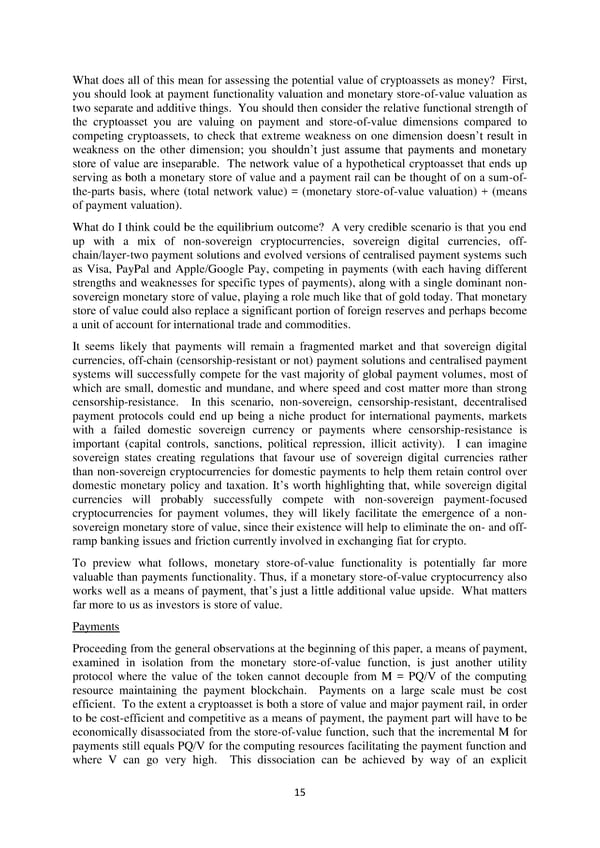What does all of this mean for assessing the potential value of cryptoassets as money? First, you should look at payment functionality valuation and monetary store-of-value valuation as two separate and additive things. You should then consider the relative functional strength of the cryptoasset you are valuing on payment and store-of-value dimensions compared to competing cryptoassets, to check that extreme weakness on one dimension doesn’t result in weakness on the other dimension; you shouldn’t just assume that payments and monetary store of value are inseparable. The network value of a hypothetical cryptoasset that ends up serving as both a monetary store of value and a payment rail can be thought of on a sum-of- the-parts basis, where (total network value) = (monetary store-of-value valuation) + (means of payment valuation). What do I think could be the equilibrium outcome? A very credible scenario is that you end up with a mix of non-sovereign cryptocurrencies, sovereign digital currencies, off- chain/layer-two payment solutions and evolved versions of centralised payment systems such as Visa, PayPal and Apple/Google Pay, competing in payments (with each having different strengths and weaknesses for specific types of payments), along with a single dominant non- sovereign monetary store of value, playing a role much like that of gold today. That monetary store of value could also replace a significant portion of foreign reserves and perhaps become a unit of account for international trade and commodities. It seems likely that payments will remain a fragmented market and that sovereign digital currencies, off-chain (censorship-resistant or not) payment solutions and centralised payment systems will successfully compete for the vast majority of global payment volumes, most of which are small, domestic and mundane, and where speed and cost matter more than strong censorship-resistance. In this scenario, non-sovereign, censorship-resistant, decentralised payment protocols could end up being a niche product for international payments, markets with a failed domestic sovereign currency or payments where censorship-resistance is important (capital controls, sanctions, political repression, illicit activity). I can imagine sovereign states creating regulations that favour use of sovereign digital currencies rather than non-sovereign cryptocurrencies for domestic payments to help them retain control over domestic monetary policy and taxation. It’s worth highlighting that, while sovereign digital currencies will probably successfully compete with non-sovereign payment-focused cryptocurrencies for payment volumes, they will likely facilitate the emergence of a non- sovereign monetary store of value, since their existence will help to eliminate the on- and off- ramp banking issues and friction currently involved in exchanging fiat for crypto. To preview what follows, monetary store-of-value functionality is potentially far more valuable than payments functionality. Thus, if a monetary store-of-value cryptocurrency also works well as a means of payment, that’s just a little additional value upside. What matters far more to us as investors is store of value. Payments Proceeding from the general observations at the beginning of this paper, a means of payment, examined in isolation from the monetary store-of-value function, is just another utility protocol where the value of the token cannot decouple from M = PQ/V of the computing resource maintaining the payment blockchain. Payments on a large scale must be cost efficient. To the extent a cryptoasset is both a store of value and major payment rail, in order to be cost-efficient and competitive as a means of payment, the payment part will have to be economically disassociated from the store-of-value function, such that the incremental M for payments still equals PQ/V for the computing resources facilitating the payment function and where V can go very high. This dissociation can be achieved by way of an explicit 15
 Investor’s Take on Cryptoassets by John Pfeffer Page 14 Page 16
Investor’s Take on Cryptoassets by John Pfeffer Page 14 Page 16